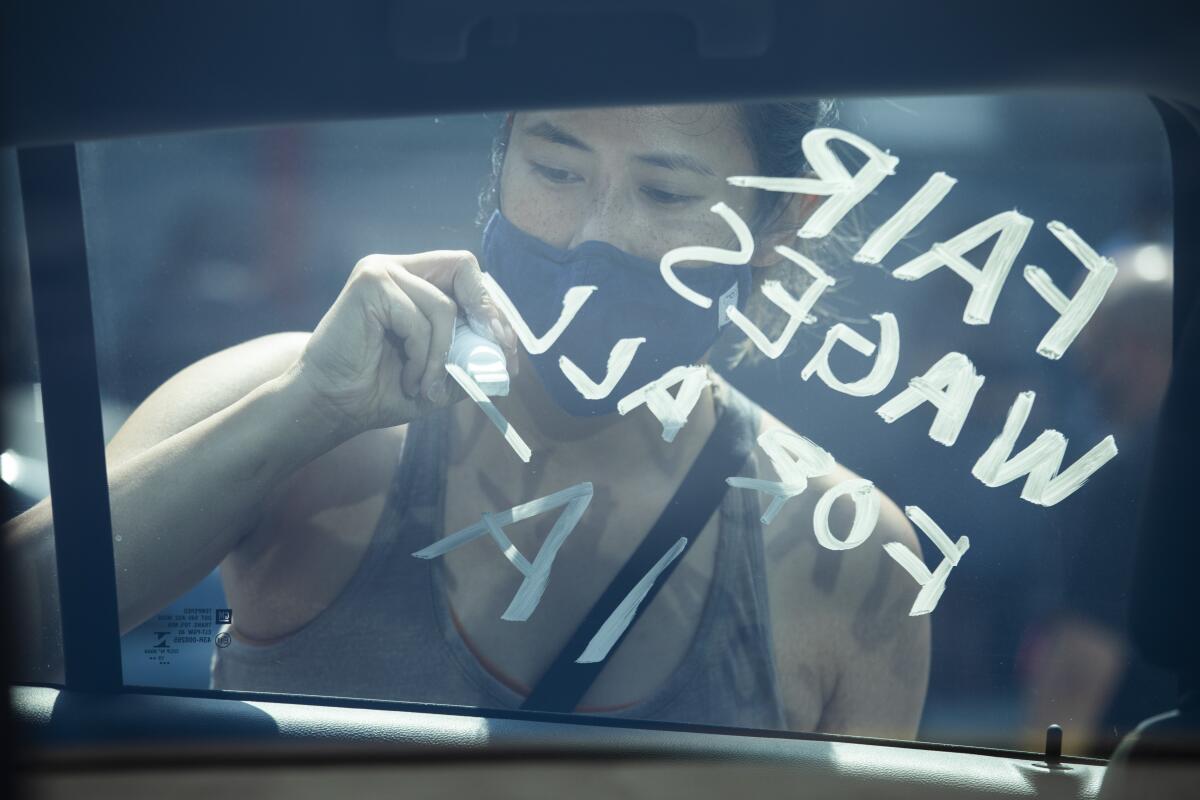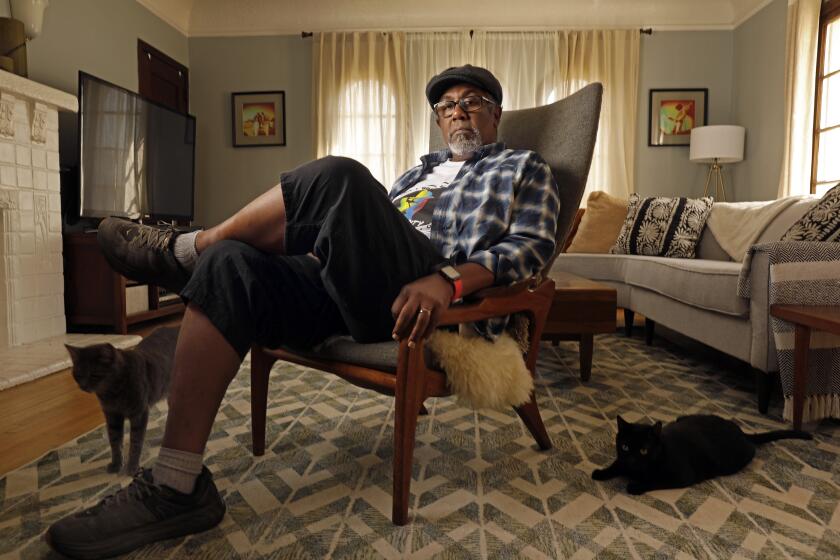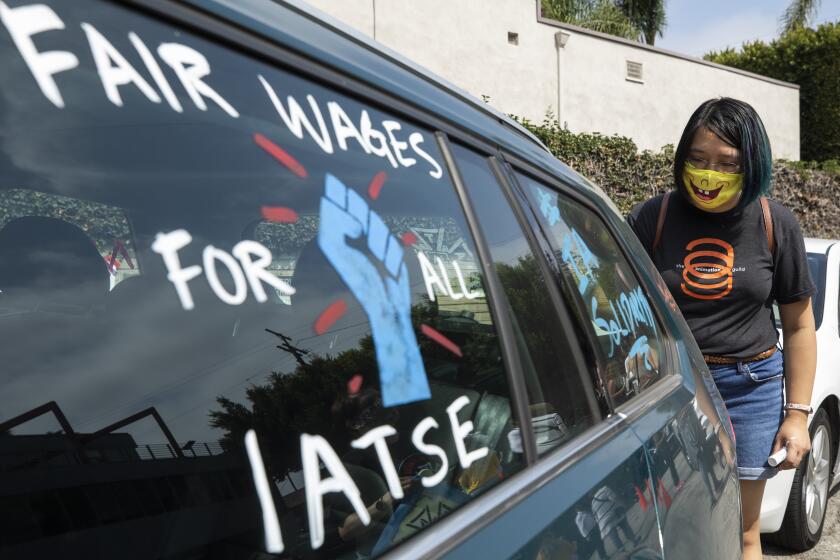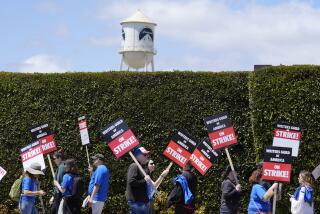Hollywood strike averted: How studios and crews union reached a deal

IATSE member Donna Young at a union rally on Sept. 26. Workers and producers reached a tentative agreement on Saturday.
- Share via
The world’s mightiest media companies bowed this weekend to demands of Hollywood worker bees: the lighting and sound technicians, carpenters, makeup artists, set decorators, costume designers and others who work behind the scenes on film and TV sets.
It was a rare display of muscle for the industry’s “below-the-line” production crews, who were threatening to stage a devastating strike.
The deal reached Saturday between Hollywood’s major studios and leaders of the crews’ union, the International Alliance of Theatrical Stage Employees, includes 3% annual wage hikes, improvements in pay and conditions on streaming productions, observance of the Martin Luther King Jr. holiday, and a rest period of 10 hours between daily shoots and 54 hours on weekends.
“We went toe-to-toe with some of the richest and most powerful entertainment and tech companies in the world,” IATSE International President Matthew Loeb said in a statement that announced the tentative accord. “Our members stood firm.”
The companies — Walt Disney Co., Netflix, Amazon, Apple, Sony Pictures Entertainment, NBCUniversal, ViacomCBS and WarnerMedia — were forced to abandon their take-it-or-leave-it approach to the talks, which had been dragging on for five months. The companies’ negotiating arm, the Alliance of Motion Picture and Television Producers, declined to comment. But one person familiar with the negotiations who was not authorized to speak publicly, said: “This is a good deal for both sides.”
It’s not a done deal. About 40,000 union members from 13 Hollywood locals must still approve the pact. Although union leaders expect a majority of members will support the proposed three-year contract, some IATSE members on social media lamented that the proposals didn’t go far enough. Several members said 3% annual raises were unacceptable when the inflation rate this year is 5.4%. Others argued the deal wouldn’t entirely eliminate grueling workdays.
“I’ve had too many people weeping on the floor of my office in exhaustion,” costumer designer Terry Dresbach said in an interview. Although she’s awaiting more details and unsure how she will vote, Dresbach said she’s leaning toward voting no. “I’m not seeing any improvement for quality of life for people.”
But Nelson Coates, president of the Art Directors Guild IATSE Local 800, told members Sunday that it was a strong contract.
“The employers moved on issues some thought would never be addressed,” Coates said. “Several senior members of the bargaining committee have been fighting for improved turnaround and weekend rest for nearly three decades.”
Studio executives acknowledged offering more concessions than planned.
With the clock racing toward a midnight Sunday deadline for a strike, the studios backed down late Friday over issues of meal breaks and rest periods, according to four people with knowledge of the talks.
Early on, studios suggested allowing workers 48 hours of rest time on weekends, according to one of the knowledgeable persons. But that scenario still would have allowed overnight shoots that begin Fridays and bleed into Saturday mornings, a practice known in the industry as “Fraturdays.” Studios then offered 50 hours of weekend rest time but IATSE negotiators said “no.”
Film crews are tired of tough working conditions and low pay from streaming companies and preparing to strike.
By Friday, the studios largely gave in, promising craft workers the same amount of rest — 54 hours over the weekend — as big-name stars. The studios also agreed to raise financial penalties for producers who force crews to skip meal breaks.
Two industry veterans — entertainment attorney Ken Ziffren and senior Disney executive Peter Rice — played key roles in resolving the standoff.
The studios also made a commitment to fund the union’s health and pension plans, which are facing a $400-million deficit.
By last weekend, the entertainment companies recognized they were playing a losing hand.
Such huge companies couldn’t defend 16-hour-plus workdays, nor could they cite financial losses when their earnings and stock prices were up. Consider that Disney’s stock has soared 82% since the start of the pandemic. Disney now is worth $320 billion.
In addition, Disney was fresh off the Scarlett Johansson lawsuit debacle — a rare public relations stumble for the Burbank behemoth. Some fans accused the company of being greedy — and taking advantage of a woman, which the company disputed. Disney and Johansson’s attorneys quickly settled the case last month.
Two factors — the COVID-19 pandemic and the boom in TV production to feed the proliferation of streaming services — played enormous roles in the labor tensions, according to interviews with a dozen studio executives and IATSE members.
Some executives acknowledged the studios initially underestimated the angst among crews. Complaints about long hours had been magnified as producers pushed crews harder to make up for lost time caused by production shutdowns.
Nationwide, dissatisfied and burned out workers have been quitting their jobs in record numbers. The labor movement is gaining momentum. Last week, more than 10,000 unionized John Deere & Co. workers in Iowa, Kansas and Illinois walked out after rejecting a labor agreement that their union hammered out with the company.
IATSE also demanded the studios bend because the union played a key role in a June 2020 agreement that enabled Hollywood production to resume after a three-month shutdown.
The pandemic also introduced another element.
“During COVID, everyone got a chance to take some time off and we realized, ‘Wow!, this is what we’ve been missing,’ ” said Joe Holdman, 30, a lighting director and member of the IATSE Local 728. “We got new perspective and a taste of what life could be like.”
Thousands of IATSE crew members returned to work in late summer 2020 with great anxiety because COVID-19 infections were rampant in Los Angeles, New York and other production hubs — and workers were confined with dozens of others for hours on end.
Approaching the talks, the producers had been banking on precedent. In its 128-year history, IATSE has never gone on strike.
But studio executives were rattled in late September when IATSE members returned a vote of nearly 99% in support of a strike. Soon, labor-friendly politicians, including U.S. Sen. Bernie Sanders (I-Vt.), U.S. Sen. Alex Padilla (D-Calif.) and Rep. Alexandria Ocasio-Cortez (D-N.Y.), jumped into the fray to rally for support of workers.
“The nature of this industry makes it hard to push back and speak up,” said Nithya Raman, a Los Angeles City Council member whose district includes parts of Hollywood. “It’s a freelance industry, and if you were to push back against working conditions, even if you’re in a union, that still jeopardizes your ability to get more work.”
The studios were also worried that an IATSE strike would embolden other unions, particularly the SAG-AFTRA and the Writers Guild of America, West, whose newly elected president Meredith Stiehm has already telegraphed that writers will press hard for a greater share of streaming profits in the next round of negotiations. The WGA’s current contract expires in 2023.
Earlier this month, the International Alliance of Theatrical Stage Employees voted in support of waging a strike if the union couldn’t agree to a new contract.
More to Read
Inside the business of entertainment
The Wide Shot brings you news, analysis and insights on everything from streaming wars to production — and what it all means for the future.
You may occasionally receive promotional content from the Los Angeles Times.














